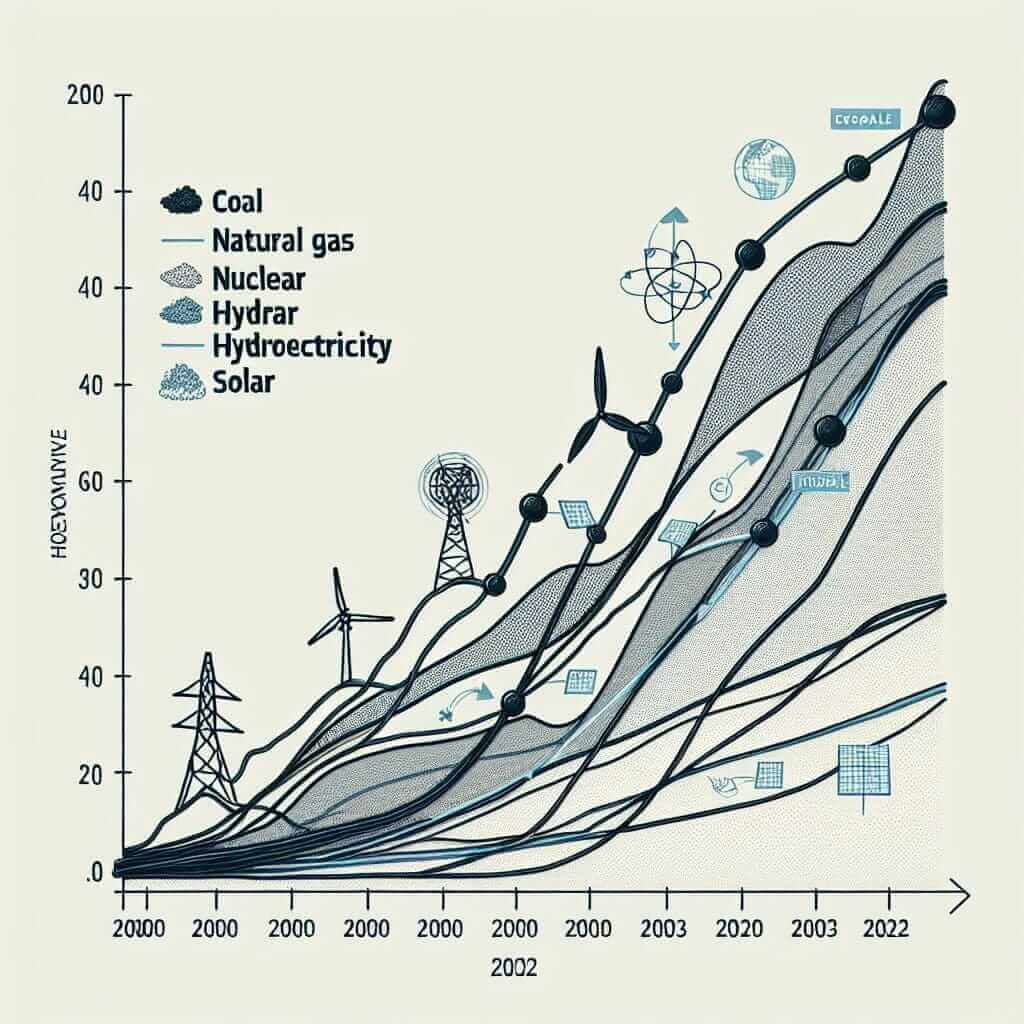Understanding trends in energy production is essential for grasping global economic and environmental changes. This topic often appears in IELTS Writing Task 1, where candidates are required to describe and analyze data from graphs, charts, or tables. In this article, we will explore this topic in detail, providing a comprehensive guide to help you excel in this section of the IELTS exam.
Below are two sample IELTS Writing Task 1 questions that relate to the topic “Trends in Energy Production (2000-2023)”:
- The graph below shows the changes in the production of different types of energy in Country X from 2000 to 2023.
- The table below illustrates the amounts of renewable and non-renewable energy produced in four countries in three different years.
Sample Question
Let’s select the first task for our sample analysis:
“The graph below shows the changes in the production of different types of energy in Country X from 2000 to 2023.”
Creating a Sample Graph
To aid our analysis, we will create a hypothetical graph:

Data Description
Our graph indicates the production levels of coal, natural gas, nuclear, hydro, and solar energy from 2000 to 2023. Key points include:
- Coal production started at 50 units in 2000 and dropped to 20 units by 2023.
- Natural gas production fluctuated slightly, starting at 30 units and ending at 35 units.
- Nuclear energy saw a continuous rise from 10 units to 50 units.
- Hydro energy maintained stable production, slightly increasing from 15 to 20 units.
- Solar energy had a significant increase, sharply rising from 5 units to 60 units.
Analyzing the Graph
Understanding the Trends:
-
General Trends:
- Renewable energy sources like solar are on the rise.
- Non-renewable energy sources like coal are declining.
-
Specific Observations:
- Coal production has dramatically decreased, indicating a shift away from dirty energy.
- The steady incline in nuclear energy suggests increased investment in nuclear power.
- Solar energy’s rapid growth highlights advancements in solar technology and its declining cost.
Sample Writing Task 1 Answer
Here is a model answer for the sample question:
The graph illustrates the trends in the production of five types of energy in Country X from 2000 to 2023.
Overall, production of coal and hydro energy saw a decline, while nuclear and solar energy experienced a significant increase. Natural gas production remained relatively stable throughout the period.
To begin with, coal production started at 50 units in 2000, but it consistently decreased over the years, reaching just 20 units in 2023. In contrast, nuclear energy showed a steady rise, from 10 units in 2000 to 50 units by the end of the period, reflecting a fivefold increase.
Solar energy production began at a modest 5 units, but it underwent a dramatic surge and peaked at 60 units by 2023. This signifies a growing trend towards renewable energy sources. Natural gas production, however, demonstrated minor fluctuations, oscillating between 30 and 35 units.
Hydropower showed minimum variations, starting at 15 units and slightly increasing to 20 units in 2023. Consistently low but steadily rising, hydropower remained the least volatile of all energy types displayed.
In summary, the production patterns in Country X depict a clear shift from traditional non-renewable energy sources like coal towards more sustainable options such as solar and nuclear power.
Word count: 200
Tips for Writing
- Structure: Ensure your response has a clear introduction, body paragraphs, and a conclusion.
- Tenses: Use the past tense to describe historical data and the present perfect for trends continuing into the present.
- Vocab and Synonyms: Employ a variety of terms to describe trends (e.g., ‘increase,’ ‘rise,’ ‘surge’ for growth; ‘decrease,’ ‘decline,’ ‘drop’ for reduction).
- Data Reporting: Accurately refer to data points and range for precise reporting.
Important Vocabulary
- Renewable (adjective) /rɪˈnjuːəbəl/: Capable of being replenished naturally.
- Non-renewable (adjective) /ˌnɒn rɪˈnjuːəbəl/: Resources that cannot be easily replaced.
- Fluctuate (verb) /ˈflʌktʃueɪt/: To change frequently, especially in size or amount.
- Decline (verb) /dɪˈklaɪn/: To decrease in quantity.
- Surge (noun) /sɜːdʒ/: A sudden and great increase.
- Stable (adjective) /ˈsteɪbəl/: Consistent, showing little change over time.
Conclusion
In conclusion, understanding trends in energy production and effectively describing these trends using accurate data and appropriate vocabulary are crucial for excelling in IELTS Writing Task 1. By analyzing graphs, identifying key trends, and practicing structured writing, one can achieve high band scores. Remember to focus on clarity, precision, and varied vocabulary usage. Good luck!